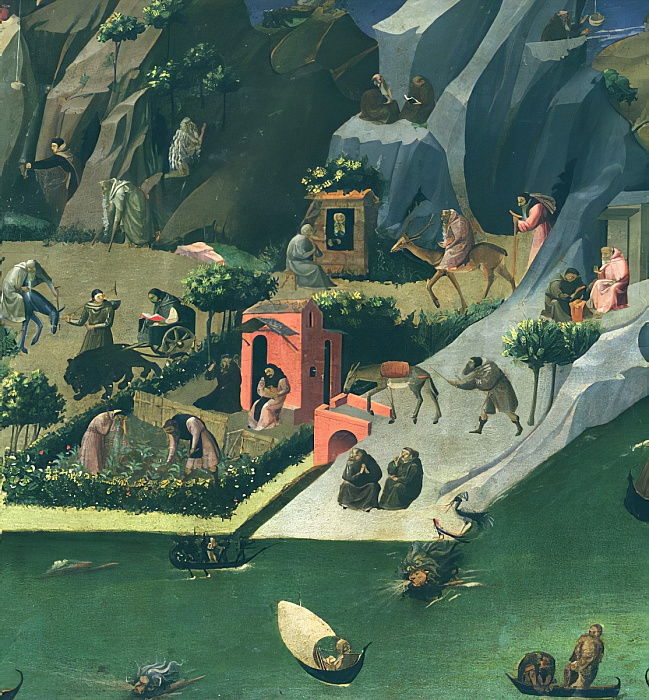 This Thebaid attributed to Gherardo Starnina (1354-1413) is one of many such painting that told the stories of some early Christian monks and hermits who went in the areas of Thebes, the ancient capital of Egypt. While living in the desert these individuals supposedly lived and prayed in solitude and privation but were often tempted by devils of various sorts. Starnina’s interpretation of the genre shows a somewhat desolate area full of animals and people including at least one hermit with a small abode and a garden.
This Thebaid attributed to Gherardo Starnina (1354-1413) is one of many such painting that told the stories of some early Christian monks and hermits who went in the areas of Thebes, the ancient capital of Egypt. While living in the desert these individuals supposedly lived and prayed in solitude and privation but were often tempted by devils of various sorts. Starnina’s interpretation of the genre shows a somewhat desolate area full of animals and people including at least one hermit with a small abode and a garden.
The scene features a monk sitting in front of a small pink dwelling that has a squarish garden in front that is separated from the house by a gate and a simple fence that keeps livestock out. The three other sides of the garden seem to be bordered by flowering shrub while large leafed plants grow in rows in the garden. The use of the back area is unknown but it does not seem to support livestock, crops or other identifiable cultivated plants.
Starnina’s vision of a hermit garden does not agree with contemporary accounts of monastic gardens but the idea of hermit gardens did capture the minds of English wealthy landowners in the 18th century when they wanted hermits to live on their estates. Lacking real ones, they actually advertised for men to come and play the role of a hermit on their estate. The hired hermits agreed to a contract of about 7 years more or less and were expected to dress like druids in return for food, board and service as a source of advice and/or entertainment. A famous ad posted by Charles Hamilton, a wealthy Englishman, reads that the successful candidate will :
” be provided with a Bible, optical glasses, a mat for his feet, a hassock for his pillow, an hourglass for timepiece, water for his beverage, and food from the house. He must wear a camlet robe, and never, under any circumstances, must he cut his hair, beard, or nails, stray beyond the limits of Mr. Hamilton’s grounds, or exchange one word with the servant.”
Getting good hermits was harder than you might think and would-be hermits were frequently fired for such crime as washing, having a beer with friends, or chatting with visitors to the estate. The purpose of having a hermit, according to the land owners, was to have a unique garden feature and having a hermit that chatted with visitors was not part of the plan.
Hermitages are still part of the garden experience in England and fun to see even if only a building that reminds visitors of a tradition from medieval times.